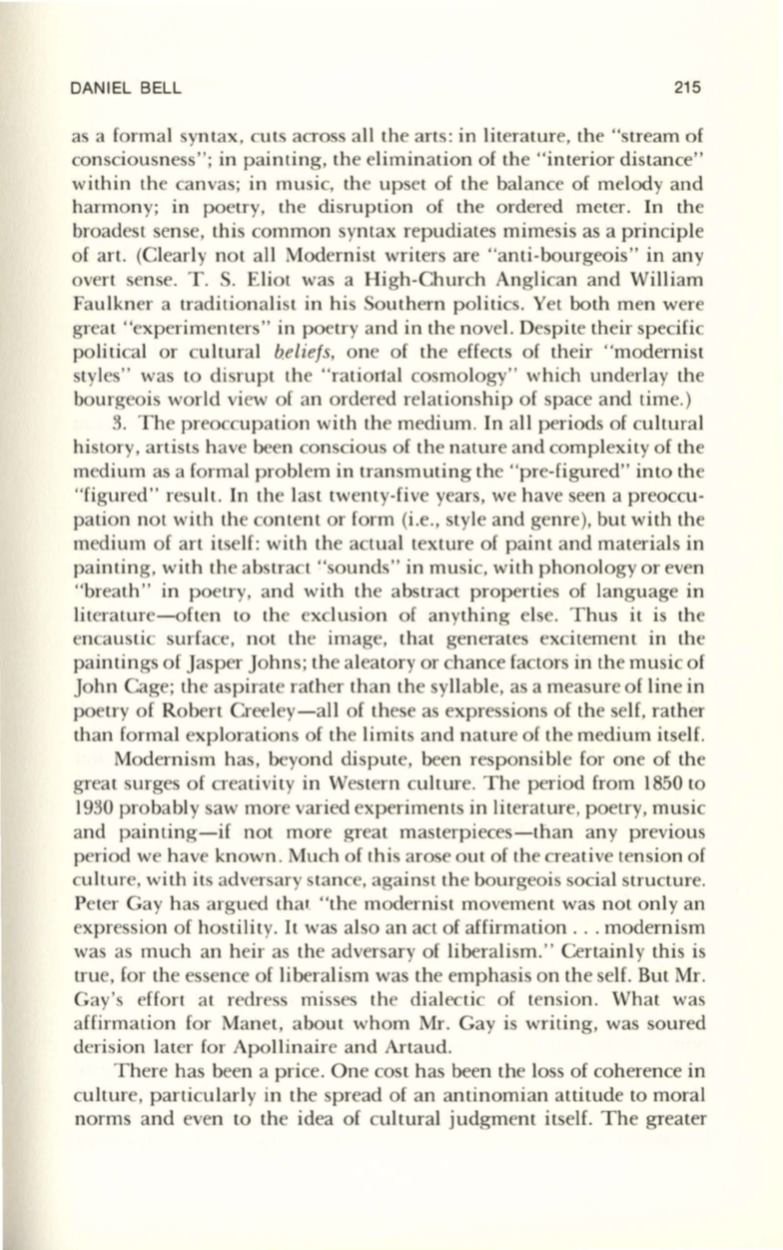
DANIEL BELL
215
as a formal syntax, cuts across all the arts: in literature, the "stream of
consciousness"; in painting, the elimination of the "interior distance"
within the canvas; in music, the upset of the balance of melody and
harmony; in poetry, the disruption of the ordered meter. In the
broadest sense, this common syntax repudiates mimesis as a principle
of art. (Clearly not all Modernist writers are "anti-bourgeois " in any
overt sense.
T.
S. Eliot was a High-Church Anglican and William
Faulkner a traditionalist in his Southern politics. Yet both men were
great "experimenters " in poetry and in the novel. Despite their specific
political or cultural
beliefs,
one of the effects of their "modernist
styles" was to disrupt the "rational cosmology" which underlay the
bourgeois world view of an ordered relationship of space and time.)
3. The preoccupation with the medium. In all periods of cultural
history, artists have been conscious of the nature and complexity of the
medium as a formal problem in transmuting the "pre-figured" into the
"figured" result. In the last twenty-five years, we have seen a preoccu–
pation not with the content or form (i.e., style and genre), but with the
medium of art itself: with the actual texture of paint and materials in
painting, with the abstract "sounds " in music, with phonology or even
"breath" in poetry, and with the abstract properties of language in
literature-often
to
the exclusion of anything else. Thus it is the
encaustic surface, not the image, that generates excitement in the
paintings of Jasper Johns; the aleatory or chance factors in the music of
John Cage; the aspirate rather than the syllable, as a measure of line in
poetry of Robert Creeley-all of these as expressions of the self, rather
than formal explorations of the limits and nature of the medium itself.
Modernism has , beyond dispute, been responsible for one of the
great surges of creativity in Wes tern culture. The period from 1850 to
1930 probably saw more varied experiments in literature, poetry, music
and painting-if not more great masterpieces-than any previous
period we have known. Much of this arose out of the creative tension of
culture, with its adversary stance, against the bourgeois social structure.
Peter Gay has argued that "the modernist movement was not only an
expression of hostility. It was also an act of affirmation ... modernism
was as much an heir as the adversary of liberalism." Certainly this is
true, for the essence of liberalism was the emphasis on the self. But Mr.
Gay ' effort at redress misses the dial ectic of tension. What was
affirmation for Manet, about whom Mr. Gay is writing, was soured
derision later for Apollinaire and Artaud.
There has been a price. One cost has been the loss of coherence in
culture, particularly in the spread of an antinomian attitude to moral
norms and even to the idea of cultural judgment itself. The greater


